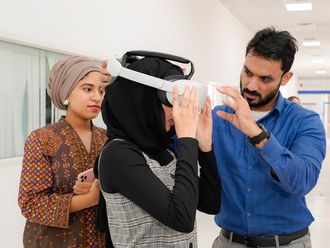
In 2017, the UAE had more than 1 million diabetics among its 9.4 million population. Although sedentary lifestyles and unhealthy diets are among the country’s major risk factors, the International Diabetes Federation (IDF) puts down the high number to a growing population as well as their improved understanding of the condition, which leads to a higher rate of diagnosis.
Diabetes is a lifelong disease but unlike many other conditions, this one can affect all the organs of the body. So it is crucial to educate the patient and meticulously follow structured tests to control blood sugar levels and detect potential organ complications early, says Dr Alex Kalayil, Specialist Internal Medicine at Al Noor Polyclinic, Deira and Director of Amber Clinics’ diabetes programme. “Thorough follow-up exams with consideration of all aspects of the disease cannot be done by the patient alone without being enrolled in a structured management programme.”
Patients diagnosed at Amber Clinics are a part of its diabetes management programme, where they are mentored in all elements of the disease to ensure an excellent quality of life. This includes primary and secondary treatments to control the disease, assessment and screening for all potential complications, tracking and reminding patients of follow-up examinations, and continuous assessment and optimisation of diabetes treatment.
Amber Clinics also runs regular educational sessions for its diabetes patients. The Diabetes Conversation Map, recommended by the American Diabetes Association, consists of a series of interactive sessions, each attended by about 8-12 patients and moderated by experienced diabetes nurses and/or physicians.
“Studies have proven that diabetics who followed this particular patient education programme had better long-term outcomes, better quality of life and less complications,” says Dr Kalayil.
Effect on patients
Forty-eight-year-old Shoukath Ali swears by the clinics’ programme. “I had many misconceptions about insulin injections,” he says. “I was just not ready to switch to insulin treatment even though my blood sugar levels were not under control. After attending the sessions on insulin administration and learning from the experience of the other patients, I got more confident about the move to insulin injections.
“My blood sugar values have been under good control since then and I have started injecting insulin myself,” adds Ali, who was diagnosed as diabetic at 32.
All elements of successful diabetes management — staying active, eating healthy, controlling blood sugar, taking medicine, problem-solving, and reducing risks — are discussed during the sessions.
“I learned a lot about diabetes, its causes, effects and the required lifestyle changes,” says Mahesh Babu, 46.
Babu, who has been a diabetic for more than 10 years, says his HbA1c improved after following the educator’s instructions.
For newly diagnosed Ibrahim Peer Mohammed, listening to other diabetics at the sessions was a huge relief and lessened his sense of unease. “I do not feel alone anymore with my diabetes,” says the 36 year old.
What is diabetes?
Diabetes is caused by the body’s inability to produce insulin (type 1) or effectively use the hormone it produces (type 2). We don’t really know the exact reason behind type 1, however, type 2, which makes up the majority of diabetes cases, is a result of ageing, inactivity and excess body weight.
Another type, gestational diabetes occurs during pregnancy, where blood sugar levels rise above normal but stay below diabetic levels.
Since it can put mother and baby at increased risk of complications during pregnancy and delivery, it’s important to control the sugar levels.
About 10 per cent of healthy women are affected by gestational diabetes. Many can control it with exercise and a healthy diet. Medication is required for about 15 per cent of cases to manage glucose levels and in most cases it is a daily insulin injection.
Most women with gestational diabetes don’t have any symptoms. That’s why thorough blood sugar monitoring is critical during pregnancy.
After delivery, glucose levels usually return to normal and no further treatment is necessary. But we need to keep a watch as gestational diabetes is known to increase women’s as well as the child’s risk of developing type 2 diabetes later.
Being prediabetic — with fasting blood glucose levels between 100mg/dl and 125mg/dl — is also a risk factor. Just like gestational diabetes, prediabetes too doesn’t have any symptoms. Therefore screening is important and recommended for all adults from the age of 45 every three to five years. Obese people, women with gestational diabetes and those with a family history of diabetes are at higher risk.
If you are prediabetic
Follow a healthy diet
Exercise regularly
Lose weight
Stop smoking
For a healthy pregnancy
Most women with gestational diabetes will have a successful pregnancy and uncomplicated delivery if their glucose levels are controlled.
Follow up on the physician’s treatment plan
Eat a healthy diet and exercise regularly
Regularly monitor
your blood glucose
Keep your regular prenatal appointments













